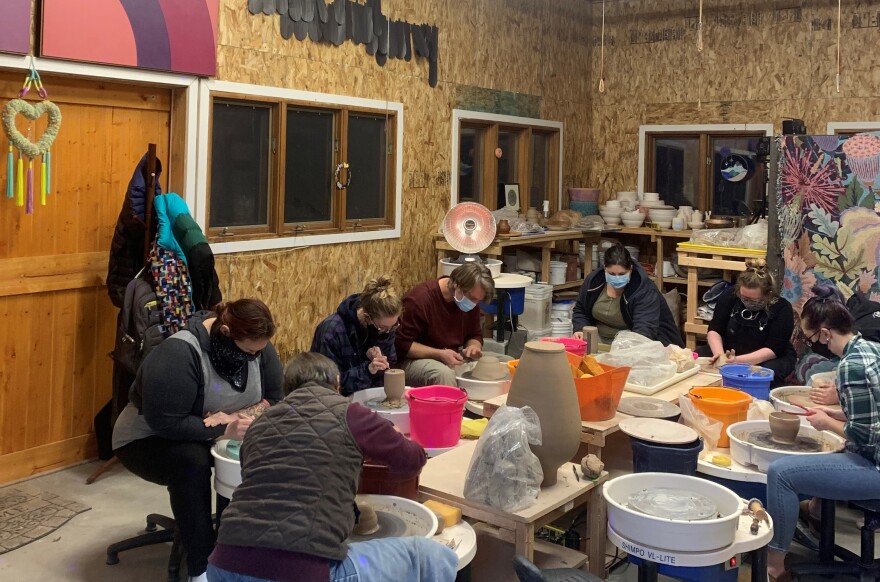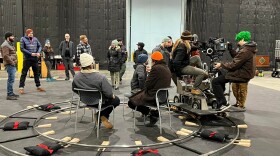The art of ceramics requires access to expensive tools and materials like a pottery wheel, kiln, and clay. This has meant the world of ceramics has been very white and exclusive. That’s something Tacoma ceramicist, phi le, is trying to change.
Back in high school in Vancouver, Washington, le was good at academics. By their senior year all that was left to take were electives and at the time, ceramics seemed like a fun option. But unlike everything else in school, working with clay didn’t come easily to them. Because of that, it only made le want to work harder.

"Being a straight-A kid, I was pissed that I could not do it," le says. "I was so angry. I'm like, 'this has to be possible for someone like me!' So I practice and practice and practice and here I am today. I haven't stopped since."
le went on to study ceramics at the University of Washington. It was there that they first encountered the barriers that prevent so many people from pursuing the arts. le is a child of immigrants from Vietnam and they have worked since they were 14.
To attend college, le worked two jobs. They took on a third to buy ceramics supplies. le says that their professors didn’t seem to care about this additional workload when evaluating their performance.
"Here I am, working like hours and hours and hours and then coming into class and being told you're not working hard enough in this course, because you're not here for every single extra session that's available," le says.
At the time, le was also the only student of color in the ceramics department. Ultimately they left the program.
As a Black person, Shellys Owens relates to le's experience. Owens is currently an instructor at Phi Pottery, the studio le opened in Tacoma in 2017.
"A lot of the other studios are expensive and a lot of the people that have access to that kind of money are white," Owens says. "It can be uncomfortable to go into a space full of that."
le saved all the money from selling their work for a couple of years to start the studio. At first, it was just four pottery wheels in their garage. Now there are 10 wheels with as many as 60 students passing through the expanded garage space each week.

They've got several kilns including one out in their backyard, as well as a wedging area and space for hand building. Over in the corner of the studio, le shows me some of their work. There are big planter bowls that haven’t been fired yet with mermaid bunnies carved into the outside.
"I love mash ups," le says. "I just love things that don't necessarily go together, but somehow they do and when you put them together, the symbol of it changes. For me, the mermaid bunny is a storytelling device; the bunnies are also witches. They cast magic spells, they have magical familiars, and they deal with lots of like emotional things so their spells are about healing, about holding sadness, about overcoming anger. Stuff like that."
Also on the table are an array of bottles. They vary in size and color but all look similar enough that they appear to belong together as a collection. le says picking a single style and developing a sort of “brand” is one of the many unspoken requirements for entry into the traditional ceramics world. But le rejects this idea.
It’s an example of their resistance to the status quo that exists in ceramics – like rebuffing the expectation of a college degree or an unpaid apprenticeship.
"If you look at it, the only people who can do that are people who are already generationally wealthy," le says. "We find time and time again, the folks without means are people of color."
le’s studio operates on a sliding scale allowing self-identifying Black, Indigenous, and people of color, the option to pay what they can afford to learn the craft. There’s also a scholarship option for eligible students to pay nothing and no cap on the number of scholarships le provides.

A year after starting, Atela Tinnin, a student who took advantage of the sliding scale price, says she is now doing what she’d never imagined: selling her work.
"I gained a lot more than just pots and cups and things like that from going to the studio," Tinnin says.
le serves as an informal mentor for her. Tinnin frequents the studio, taking advantage of the free drop-in sessions for BIPOC students.
le’s philosophy is simple: Everyone deserves to be an artist. Because it’s one of the most human things one can do. To create something and share it with others.
"You forget that you're a person and a person is a creator; that's what we came to Earth to do," le says. "With pottery, what we're always doing is making something to share — it's not ever really only for you."
It may be something that the ceramics world seems to forget, but le won’t. Their studio is a testament to their belief that art should be created and shared by everyone.









